| |
| Page
Menu |
|
|
By
clicking on the
title on the right, you will go directly to each example.
(Click on the green up arrow at the end of each example to go back to the top of this page.)
(The examples have been kept on 1 web page so that you can print
all of them with 1 print command in your browser.) |
|
- A working professional seeking to increase
interpersonal skills after a performance appraisal commenting
on the need to improve teamwork
- An personal performance coach
working with an individual client
- An adult educator teaching a class
on organizational behavior
- An adult educator teaching a class on group dynamics
- An HR consultant delivering a professional development program
on supervisory skills to new managers and team leaders
- An external consultant working with
a group of department managers to develop their teamwork abilities
- A mediator working with a couple in crisis
- A task force leader charged with developing a sense of team
in a new formed project team
- A business coach working with the two partners
who own a business
- An independent consultant, trainer,
or group facilitator looking to expand the services offered
to clients
|
| One |
|
|
A
working professional seeking to increase interpersonal skills
after a performance appraisal commenting on the need to improve
teamwork
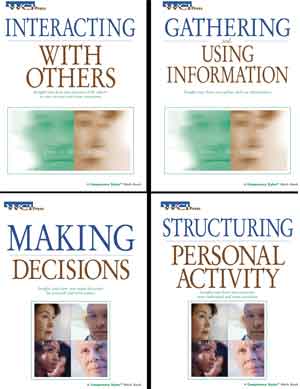
|
|
- After meeting with the boss, a working professional meets with
an HR consultant to talk about how to address performance appraisal
comments that suggest improving teamwork skills.
- The HR consultant recommends that the individual start by working
through the Interacting with
Others Competency Styles® work book.
- The individual orders the work book, completes the questionnaire
in the front and reads the interpretation section.
- Following the self development suggestions in the back of the
work book, the individual start to work through each of the five
behavior areas in turn, trying out new behaviors in team meetings
and work sessions.
- After 2 months, the individual repeats the process with the
Making Decisions work book.
- Over the next 2 quarters, the individual works through the Gathering and
Using Information and the Structuring Personal
Activity work books.
- In the following year's performance appraisal, the individuals
is complimented on the steady increase
in teamwork skills exhibited over the year.
|
| Two |
|
|
A
personal performance coach working with an individual executive
The coach in the example to the right is using the steps of the
personal competence development cycle shown below to structure
the client's development of new skills.
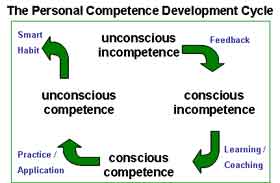
Coaches and their clients may find a"Guide to Coachees" useful as they plan their work together.
|
|
- After initial meetings with the executive client, the coach determines
that the executive needs focused competency development in effective
decision making in one-on-one and group situations. As well,
the coach concludes that the individual will benefit from deeper
insight into the dynamics of work
in groups.
- The coach acquires a copy of Making Decisions and
Interacting with
Others work books and asks the client to complete them. They
meet to discuss the client's results over two sessions, using the Personal
Profile (page 35) in each to organize their dialogue.
- In subsequent sessions, the coach and the client use the Personal
Profile (page 35) in the Making Decisions work book
to make guesses or "hunches" about the likely
behavior patterns of each of the client's subordinates in
each of the five decision making behavior areas. The coach "assigns" the
client in-between session "homework". The client is to
observe each subordinate's behavior, and see if their actual behavior
during the week matches the hunches about each person recorded
on the Personal Profile page.
- The coach and the client review
the "homework" and refine the
client's ability to to determine others' behavior patterns based
on observation. The coach leads the client
in dialogue about the most effective
behaviors that the client can use to interact more effectively
with each subordinate. The
coach assigns this behavior change in one behavior areas
in Making Decisions as
in between session "homework". They discuss the result
in their next session. They work their way through all of the
remaining Making Decisions behavior
areas over the next weeks. They then repeat this process
for the five behavior areas in Interacting with
Others during the following month.
- As the client's interpersonal skills increase, the coach leads
the client in the same "hunch
- observe - confirm - change behavior" learning sequence
for each of the client's peers, and then
superiors. The
coach has structured the learning sequence to go from less risky
interactions (subordinates) to more risky ones (peers and then
superiors). They now focus on specific the behavior areas in Making Decisions and Interacting with
Others that are most relevant to the client's interaction
with each individual. The client becomes more and more capable
of moving from insight (conscious competence) to new behavior (unconscious
competence). The client is developing effective "smart
habits" based. More and more, the client applies these new
effective smart habit "spontaneously", in response to behavior
on the part of others. The coaching process has moved the client
through a development cycle that
results in behavior change on-the-job.
|
| Three |
|
|
An Adult Educator teaching
a class on organizational behavior

|
|
- A professor at a community college is planning the curriculum
for a course on organizational behavior. One module of the course
covers self awareness and managerial
effectiveness.
- To ground the students, and provide them with insight into
their own behavior patterns, the professor decides to incorporate
the Interacting with
Others Competency Styles® work book
into the course.
- Each student gets a copy of the work book, after arrangements
have been made to make it available as in the college bookstore
as one of the required texts for the course.
- At the appropriate point in the course, each student completes
the work book as a homework assignment. They all bring their
results to class.
- The professor delivers a lecture on
the importance of self-awareness, and awareness of others' behavior
patterns, in effective managerial behavior. Specific references
to the 5 behavior areas covered in Interacting with
Others allow the professor to discuss
differences in effective managerial behavior in a systematic
way.
- Students move onto a short
assignment. They must prepare a
brief presentation in
which they are to use their Interacting with
Others Personal
Profiles (page
35) to analyze how they
interact with at least one other person, either
at work, or in some other group activity. They must document
the other person's behavior patterns by giving specific examples
that document the location of the other individual in each
Interacting with
Others behavior area, thereby increasing their observation
skills and their awareness of differences in others.
|
| Four |
|
|
An Adult Educator teaching a class
on group dynamics
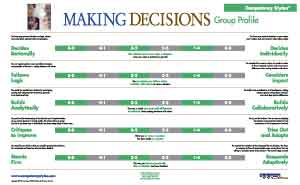
Making Decisions Group
Profile Wall Poster
(approximately 3.5 by 5 feet)
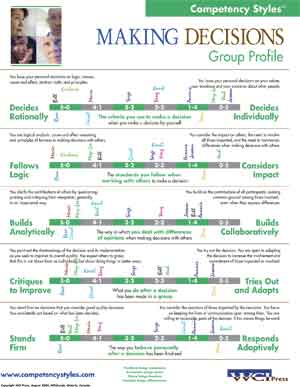
Completed Making Decisions Group
Profile
(8.5" by 11")
|
|
-
A professor at a university is responsible for
a senior level course on group dynamics. The course includes
an experiential module in which the students are required to
analyze group
decision making dynamics .
-
The professor uses the large Making Decisions wall
poster, as well as a pad of the small Making Decisions Group
Profile forms (both available directly from WCI Press). As well,
he has included the Making Decisions
Competency Styles® work book
as one of the required texts for the course.
-
Early in the
course, students complete their Personal
Profiles (page
35). The professor makes arrangements for students to photocopy
this page for each other student in the course.
-
At the appropriate session in the course, the
students post their personal results on the large Making Decisions wall
poster. Each student has been supplied with one of the small Making Decisions Group
Profile forms from the pad. They use
it to prepare a personal copy of
the group profile.
-
The class moves onto a business
simulation in which they break
into small groups and compete against one
another through making a series of product, pricing and marketing
decisions.
-
At the end of the simulation, the professor sets
an assignment in which the students are to analyze their decision
making process in their small groups, using their
copies of the Group Profile, as well as their understanding of
the Forming,
Norming, Storming, Performing model of group development,
. They are explicitly told to focus on how they made their decisions,
and not on the content of the decisions they reached. The professor's
intent is to help understand that group
decision making involves both group development as well as interpersonal
dynamics.
. |
| Five |
|
|
An
HR consultant delivering a professional development program on
supervisory skills to new managers and team leaders
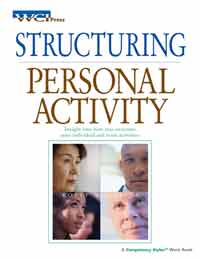
|
|
- An HR consultant is responsible for updating the supervisory
skills development program delivered to all new supervisors and
team leaders in the organization.
- The HR consultant incorporates the Structuring Personal
Activity Competency
Styles® work book into the module of the program
that deals with work assignment
and task delegation. The consultant
knows that new supervisors, managers and team leaders often
assume that others work the same way that they do. As a result,
they do not have the mental models
and interpersonal awareness to adjust their work assignment
behavior to the personal work style of each subordinate.
- The participants complete the work books before they attend
the program. They bring their completed copies to the program.
- During the module on work assignment and task delegation, the
HR consultant describes a number of examples of each, and shows
how it would be done differently
for individuals at each end of the Focus
Through Schedule - Focuses Through Variety, the
Structures in Advance -Lets Structure
Emerge, and the Creates
in Advance - Creates Under Pressure behavior areas.
-
The participants move onto a
case in which they explore effective delegation to
different subordinates.
|
| Six |
|
|
An
External Consultant working with a group of department managers
in order to develop their teamwork abilities

Making Decisions Group
Profile Wall Poster
(approximately 3.5 by 5 feet)
|
|
- A consultant has been hired by an organization to work with a
group of managers who have difficulty collaborating with one another.
Recent product and organizational structure changes will require
them to do so more and more in the future.
- After talking with a number of the manager's superiors, the consultant
decides to do a "developmental intervention", concluding
that the managers' problems based
on a lack of experience with teamwork, rather than on specific
personality dynamics and historical conflict between the individuals.
- The consultant schedules a one day
"learning" workshop on group decision making and conflict.
The consultant asks each manager to complete the Making Decisions Competency
Styles® work book on their own time. In the morning,
the consultant follows the workshop design included in WCI Press's Making Decisions Workshop
Facilitator's Kit.
- In the afternoon, the consultant facilitates
a working session on the collaborative processes that the managers
will require in the future. The consultant asks the managers
to start designing the processes that they will use to carry
out their joint work. The consultant has left Making Decisions Group
Wall Poster has been left hanging on the wall. Its presence influences
the managers as they carry out their dialogue. By the end of the
afternoon, they realize that they have only begun to discuss
what they will need. They conclude is that they will have to
make an ever
increasing number of "unstructured" decisions in future,
in two, three's and in small groups. Information
will be a vital component of this work.
- Based on their conclusions, the consultant suggests that the
group get together again to extend their work. The consultant suggests
that they use the same format - a morning workshop based on the Gathering and
Using Information work book followed by an afternoon session
in which they resume their work on the new processes that they
will need. The managers agree.
- Once again, the consultant uses WCI Press's Gathering and
Using Information Workshop
Facilitator's Kit to structure the morning. Over the
lunch break, the consultant hangs the Making Decisions Wall
Poster up on the wall, and uses small Post-It notes to
re-create the group's profile. As a result, the group has both
group profiles (Making Decisions and Gathering and
Using Information) up on the wall as they resume their
work on their new processes. By the end of the session, the managers
have made significant inroads on how they will work together in
future. Their experience in these two days together has started
their collaborative process.
- Over the next months, the consultant will meet with the group
once a month in a two hour meeting. They will discuss their progress,
and refine the processes that they are using to collaborate with
one another.
|
| Seven |
|
|
|
|
- An individual who practices in family mediation and counseling
is working with a couple who is considering
divorce. They have several
children, and are each concerned about the impact that
a divorce could have on them. At the same time, they are deeply
frustrated with the dynamics of their relationship. The
mediator contracts with them to work with them until they make
a final decision about divorce. If they decide to do so, the
mediator agrees to work with them to outline the terms of their
divorce agreement.
- As the three of them meet and dialogue about their current
feelings and the state of the relationship, the mediator realizes
that these two individuals do not have a good
framework for understanding their individual and mutual decision
making and communication behaviors. They appear well
intentioned towards one another, and seem to want to stay in
the relationship. However, they seem unaware of the fact that
they do not "synch" well.
As a result, they miss important information about one another's'
needs, feelings, opinions and values. They do not have an effective
joint decision making process. They each often make decisions
that impact the other person without dialoguing together. This
leads to considerable anger, which is usually suppressed until
it comes out at inappropriate times in hurtful ways.
- The mediator suggests that they work through the Relating Styles Competency
Styles® work book together. Because one individual
will have to travel for a week on business, the mediator gives
each individual a personal copy of the work book and asks them
to complete them by the time they meet for their next session.
- During the next meeting, the mediator guides
the couple through
the interpretation of their results.
- In subsequent sessions, the mediator begins to
use the language and the framework provided by the Relating Styles work book to
point out how each person often does not "hear" the
other person. The couple begins to modify their interaction
based on the insights they achieve during this process.
As they do, they can begin to address the difficult and often
painful issues that are leading them to consider divorce in
a more productive manner.
-
As a side benefit, each individual begins to
use the Relating Styles framework
in order to improve their interaction with their children
and the significant others in their life space.
- As a result of their progress, the couple agrees to work through
a marital counseling process
for several months before they
come back to the issue of possible divorce. The mediator contacts
them with colleagues who will help them address their relationship
dynamics in an integrated marital/sexual therapy framework.
|
| Eight |
|
|
A
Task Force Leader charged with developing a sense of teamwork in
a newly created project team
|
|
- A small consulting / software development company has won a major
new project contract for a new client. The project team
will be composed of members from both the client and the company.
None of the individuals, including the team leader, have ever
worked together before.
- The team leader needs to quickly develop a sense of team
among the project team members. The team leader consults with
a senior project manager and an internal HR consultant. They
develop the following plan for
the first week of the team's life.
- Day One - Hold a working meeting in
which the whole team is introduced to one another for the first
time. Once the introductions are other, have the team listen
to two presentations - one by the project
sponsor
on the project goals,
anticipated deliverables and general
time framework, and a second by the team
leader on the methodologies,
processes and software tools that
will be used by the team.
- Day Two - Follow-up with a 3
day off-site session to start up the project. Day One
will be spent on a "high
ropes" session in which the team members will work
with a group of outside "adventure" facilitators to
complete a high ropes course at an off-site location. This
will give the team members a very informal way to get to know
one another. This day will be concluded with a relaxed team
dinner at the hotel where the team will spend the next 2 days.
- Day Three AM - Start early next morning and ask each individual
to complete the Interacting with
Others Competency
Styles® work book
. Spend the morning on the Interacting with
Others workshop. The internal HR consultant
will join the group for this session, and use the WCI
Press's Interacting with
Others Work Shop
Facilitator's Kit to lead this morning session.
- Day Three PM - Spend the afternoon
discussing team roles and responsibilities.Team
members will be asked to talk about their technical
skills, past experiences and current roles. The team leader
will facilitate this session. Conclude the afternoon by
presenting a general outline of
the project plan for the next 6 months. The team will
have a relaxed supper together after this session.
- Day Four AM - Start early the next morning and ask each team
member to complete the Making Decisions Competency
Styles® work book. Spend the morning on
the Making Decisions workshop.
The internal HR consultant will join the group for
this session, and use the WCI Press's Making Decisions Work Shop
Facilitator's Kit to lead this session.
- Day Four PM - Spend the afternoon breaking into the project's working
sub-groups to plan the detailed work to be done in
the next 4 to 8 weeks. Review the results in the whole
group. The team leader will take responsibility for turning
this material into a detailed project plan to be shared with
the entire team.
- Day Four Evening - At the concluding supper session, the team
leader will thank everyone. Each person will leave with a project
information package that includes
the presentations and the documentation from the working
sessions. As well, the package will include Gathering and
Using Information and the Structuring Personal
Activity Competency
Styles® work books. The team leader will
suggest that the project team members may find it
useful to complete these two work books over the life
of the project.
|
| Nine |
|
|
An
Business Coach working with the two partners who own a business
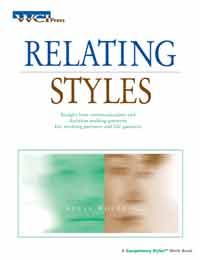
|
|
- The partners who own a successful
small business have contacted
a business coach to work with them on re-structuring their firm,
so that they can start to develop a management team below
them. Both partners believe that the business has grown to
the point where they can spend more time away from it.
- The coach uses Michael
Gerber's E-Myth framework when
working with small businesses, as well as the Relating Styles Competency
Styles® framework for helping business partners
talk explicitly about how they communicate and make decisions
together. The coach has discovered that business partners are
often "unconsciously competent"
in their communication and decision making dynamics. They assume
that subordinates will understand how they do do things,
and can easily figure out how to best work with each of them,
as well as with the two of them together. However,
this is often an issue that causes concerns or conflict for the
people who work for business partners.
- Each partner completes the work book, and the business coach
discusses the results with them. The partners discover "what
they already knew". But they realize that they now
have a language
for communicating with both their new and existing subordinates.
They can make explicit what was implicit before. It also gives
the coach quick insight into how to best work each each partner
and the two of them together.
- Based on this initial success, they move onto using the E-Myth
framework to develop their future business and management development
plans.
|
| Ten |
|
|
| An Independent Consultant, Trainer
or Group Facilitator looking to expand the services offered to clients |
|
- An independent is looking to add an "essential"
skill component to a practice. Clients
are asking for help in developing working professionals
at all levels in their teamwork
and interpersonal
skills. Clients want cost effective ways of delivering
"just-in-time" training to individuals and small
groups, at a those points in time when each individual's motivation to
look at their own behavior, and expand it, is
at its peak.
- The independent surveys the variety of "self
development" books
and training program materials that are available. Many of them
are focused on supervisory positions or on developing leaders.
Others involve the use of psychometric instruments required
extensive training or specialized certification.
- The independent talks to friends and colleagues. One of them
refers the independent to the Competency
Styles® web site
(this site). The independent explores
the site and decides to
order one of the work books as a "look-see".
- After completing the work book, the independent goes back to
the Competency Styles® web
site to see what support is offered to individuals who wish to
incorporate Competency
Styles® into
their practices. The independent sends an e-mail to WCI Press
expressing interest in the various Workshop
Facilitator's Kits.
After e-mail and telephone dialogue with WCI Press, the independent
adds Competency
Styles® workshops to the services offered to clients.
|
| |
|
|
|






